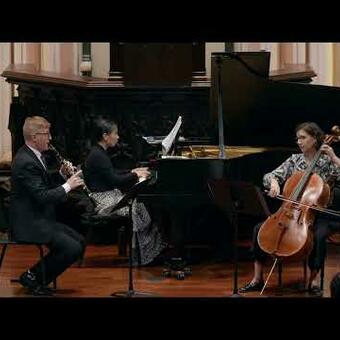Work samples
-
Bestiary (Suite for Orchestra) 2 Chimera
Chimera — a beast with a lion's head, goat's body, and serpent's tail — brays its throaty welcome (the goaty part,
of course), and prances blithely about. A few measures of blustery chords characterize the lion's regal head, but
the goatiness reasserts itself. Follows a bit of introspection on the chimera's part (is it not, after all, a creature of
many parts?). The opening prancing returns, but concludes with the addition of a snaking line of sixteenth notes,
played by the flute.Available for PurchaseMusic scores and recordings by Karen Amrhein, including "Bestiary", are available for purchase from the Happy Lemon Music Publishing website:
http://karenamrhein.com/order.html
-
Short Stories 4 Ark
"Ark" is the fourth and final movement of "Short Stories" (for string quartet and piano). "Ark" begins with an undulating figure that persists throughout half the piece, and which creates a swelling sense of anticipation. Release comes with the blooming of the triumphant main theme, quickly followed by the whisper-like conclusion.
Available for PurchaseMusic scores and recordings by Karen Amrhein, including "Short Stories", are available for purchase from the Happy Lemon Music Publishing website:
http://karenamrhein.com/
-
String Trio 1 Gliss
True to its name, "Gliss" begins the String Trio with music that is characterized by a series of falling glissandi by all three strings (violin, viola, and cello). From its very opening, this mournful and striving movement keeps trying to climb, but is continually thwarted until, at the conclusion, it slides completely down the mountain, but then breathes a sigh of resignation.
-
Missa humanis 1 Kyrie
"The Missa humanis for chorus and chamber orchestra was inspired by... a performance of Beethoven’s Missa solemnis. The inspiration was, apparently, a negative one, urging Amrhein to compose the antithesis to Beethoven’s Mahlerian masterpiece. Her setting of the Ordinary of the Mass takes a mere twelve and a half minutes.... The choral writing projects a feeling of monody despite its occasional forays into counterpoint. The result is an almost primordial take on a timeless text, and it reminds this listener of Stravinsky’s (another master of concision) Mass setting of 1948." - William Zagorski, Fanfare Magazine
About Karen
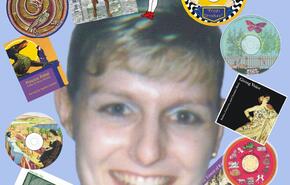
Composer Karen Amrhein has written for orchestra, wind ensemble, choir, and chamber ensemble.
Her music has been described as "seriously worth investigating for study and public performance.... Succinct in style and scope, it provides the audience a capsulized aroma of mid-twentieth century harmonic idioms as well as some fresh melodic direction.... [and it] leaves the listener wanting more." - The Horn Call
"Amrhein is tonally oriented, lyrical, and composes… more
Bestiary ~ CD Album of Music by Karen Amrhein
A bestiary is a medieval zoo on parchment. The natural history (more truly, mythology) of each animal, whether common or fantastic, serves as a prelude for a moral lesson, reflecting the medieval belief that the world itself is God's Word, and that every living thing has its own special spiritual meaning.
My "Bestiary" album is a collection of four pieces: "The Eye of Phoebus" (suite for orchestra), my "Suite for Piano", the "Symphony of Seasons" for large orchestra, and my orchestral suite "Bestiary".
The "Bestiary" suite presents two scenes and six miniature portraits of creatures from myth and fantasy: Phoenix, Chimera, Idyll (Wind in the Branches), Griffin, Sea Serpent, Unicorn, Dragon, and Parade.
"The Eye of Phoebus" suite for orchestra provides incidental music to my novel of the same name. The suite consists of a Prelude, a Passacaglia, a Badinerie, an Air, a Scherzo, and a Farewell.
The "Suite for Piano" has six movements: Dances, Fugue, Sorrow, Passacaglias, Ark, and Agnus Dei.
The "Symphony of Seasons" is built upon a simple, hymn-like melody "An Anthem for Autumn". The theme is transformed throughout the symphony, commencing with the seven variations of "Autumn".
I wore many hats for this project: producer, recording engineer (for the "Suite for Piano"), artistic designer (for the CD booklet, tray card, and disc), music contractor, and of course composer.
-
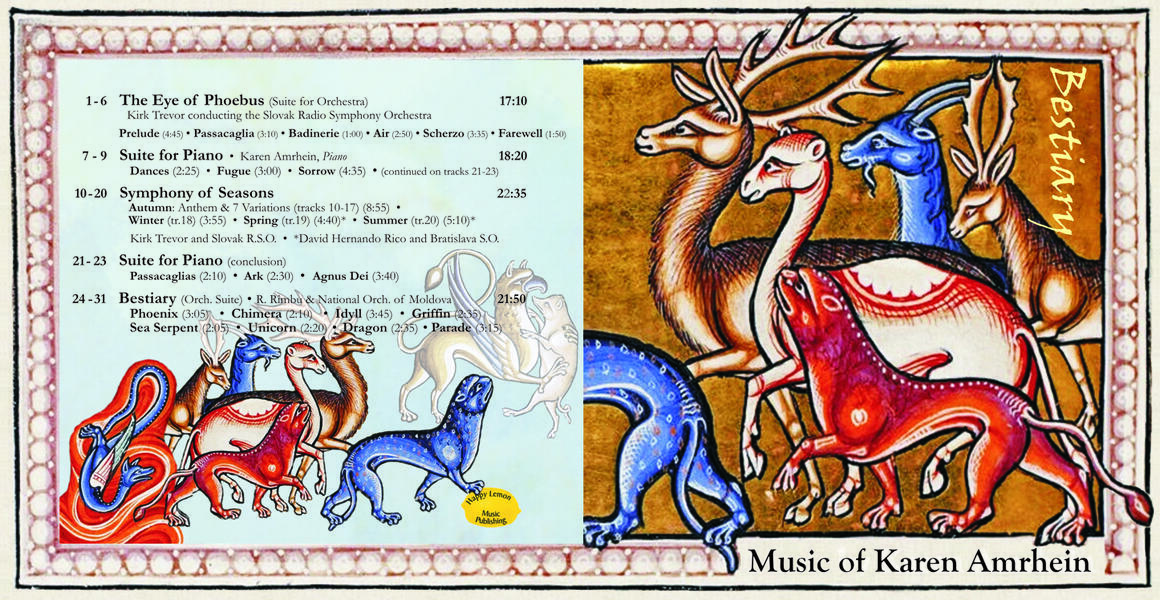 Bestiary CD
Bestiary CDMy "Bestiary" album is a collection of four pieces: "The Eye of Phoebus" (suite for orchestra), my "Suite for Piano", the "Symphony of Seasons" for large orchestra, and my orchestral suite "Bestiary".
Available for PurchaseMusic scores and recordings by Karen Amrhein, including "Bestiary", are available for purchase from the Happy Lemon Music Publishing website:
http://karenamrhein.com/
-
"The Eye of Phoebus" 1 Prelude
The "Prelude" opens "The Eye of Phoebus" suite with driving, exciting momentum.
Available for PurchaseMusic scores and recordings by Karen Amrhein, including "Bestiary", are available for purchase from the Happy Lemon Music Publishing website:
http://karenamrhein.com/
-
"The Eye of Phoebus" 2 Passacaglia
The "Passacaglia" from "The Eye of Phoebus" suite is, true to its name, a series of variations upon a ground bass. The music is slow, wistful, and lovely.
Available for PurchaseMusic scores and recordings by Karen Amrhein, including "Bestiary", are available for purchase from the Happy Lemon Music Publishing website:
http://karenamrhein.com/
-
"Bestiary" Suite 1 Phoenix
"Phoenix" conjures wonder and anticipation. The music surges until, midway, descending chords indicate the immolation of the firebird. The music builds once more and the phoenix bursts into renewed life, hearkens to the herald's trumpet, and flies away.
Available for PurchaseMusic scores and recordings by Karen Amrhein, including "Bestiary", are available for purchase from the Happy Lemon Music Publishing website:
http://karenamrhein.com/
-
"Bestiary" (Suite for Orchestra) 2 "Chimera"
Chimera -- a beast with a lion's head, goat's body, and serpent's tail -- brays its throaty welcome (the goaty part, of course), and prances blithely about. A few bars of blustery chords characterize the lion's regal head -- but the goatiness reasserts itself until it dissipates in an expressive variation. The prancing returns, but concludes with counterpoint, a snaking flute line of 16th-notes.
Available for PurchaseMusic scores and recordings by Karen Amrhein, including "Bestiary", are available for purchase from the Happy Lemon Music Publishing website:
http://karenamrhein.com/
-
"Bestiary" (Suite for Orchestra) 5 "Sea Serpent"
Sea Serpents slithers near the sea floor, searching for prey. In a sudden mood of carefree abandon it shoots toward the surface, playing and plunging amongst the waves. The humor passes and the serpent returns to the inky depths, lurking, biding....
Available for PurchaseMusic scores and recordings by Karen Amrhein, including "Bestiary", are available for purchase from the Happy Lemon Music Publishing website:
http://karenamrhein.com/
-
"Bestiary" (Suite for Orchestra) 7 "Dragon"
Dragon lurks in his gloomy cavern. He slinks and he stalks. His covetous-heart goads him to venture forth to slay and to steal, for he must increase his hoard of gold and gems and glittery things for which he has no use. He bides and broods. His terrible roving eye flashes with the fires that burn deep within. He slinks. He stalks. He bides. He broods.
Available for PurchaseMusic scores and recordings by Karen Amrhein, including "Bestiary", are available for purchase from the Happy Lemon Music Publishing website:
http://karenamrhein.com/
-
Symphony of Seasons 1 Autumn
The "Symphony of Seasons" is built upon a simple, hymn-like melody "An Anthem for Autumn". The theme is transformed throughout the symphony, commencing with the seven variations of "Autumn".
Available for PurchaseMusic scores and recordings by Karen Amrhein, including "Bestiary", are available for purchase from the Happy Lemon Music Publishing website:
http://karenamrhein.com/
-
Suite for Piano 5 Ark
"Ark" is the piano arrangement of the final movement of the piano quintet "Short Stories".
Available for PurchaseMusic scores and recordings by Karen Amrhein, including "Suite for Piano", are available for purchase from the Happy Lemon Music Publishing website:
http://karenamrhein.com/
-
Suite for Piano 6 Agnus Dei
The "Agnus Dei" was arranged for solo piano from its original setting as the final movement of the "Missa humanis" (mass for choir and chamber orchestra).
Available for PurchaseMusic scores and recordings by Karen Amrhein, including "Suite for Piano", are available for purchase from the Happy Lemon Music Publishing website:
http://karenamrhein.com/
Princess Paliné ~ A Film by Karen Amrhein
I created this animated film of my original short story that tells the tale of Princess Paliné (pronounced "Palinay"), "who learned the seven words that stay a dragon's hunger and cool its fires, thus saving her land from the great fire-serpent Malinon, when all the knights and paladins proved luckless." I wrote the music and the story, animated the film, and produced and directed it. My husband, Stephen, provided the narration.
-
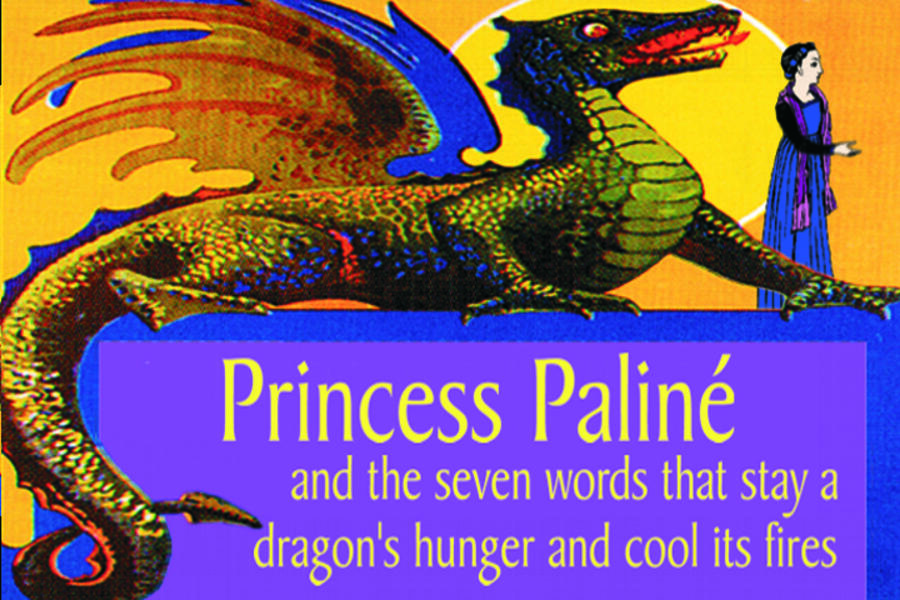 Princess Paliné ~ A Film by Karen Amrhein ~ Cover Image
Princess Paliné ~ A Film by Karen Amrhein ~ Cover ImageThis is the cover image of the animated film.
Available for PurchaseMusic scores and recordings by Karen Amrhein, including the "Princess Paliné" DVD, are available for purchase from the Happy Lemon Music Publishing website:
http://karenamrhein.com/
-
Princess Paliné ~ A Film by Karen Amrhein
This is the animated film that tells the tale of Princess Paliné (pronounced "Palinay"), "who learned the seven words that stay a dragon's hunger and cool its fires, thus saving her land from the great fire-serpent Malinon, when all the knights and paladins proved luckless." The film was created by composer Karen Amrhein, who wrote the music and story, animated the film, and produced and directed it. The narration is provide by the composer's husband, Stephen.
Available for PurchaseMusic scores and recordings by Karen Amrhein, including the "Princess Paliné" DVD, are available for purchase from the Happy Lemon Music Publishing website:
http://karenamrhein.com/
-
Princess Paliné (Chamber Suite) 1 Gardens
This is the first movement of the suite for chamber ensemble of the music for "Princess Paliné". The music is used in both the film and in the narration piece for narrator and chamber ensemble.
Available for PurchaseMusic scores and recordings by Karen Amrhein are available for purchase from the Happy Lemon Music Publishing website:
http://karenamrhein.com/
-
Princess Paliné (Chamber Suite) 2 Tutor
This is the second movement of the suite for chamber ensemble of the music for "Princess Paliné". The music is used in both the film and in the narration piece for narrator and chamber ensemble.
Available for PurchaseMusic scores and recordings by Karen Amrhein are available for purchase from the Happy Lemon Music Publishing website:
http://karenamrhein.com/
-
Princess Paliné (Chamber Suite) 3 Croquet
This is the third movement of the suite for chamber ensemble of the music for "Princess Paliné". The music is used in both the film and in the narration piece for narrator and chamber ensemble.
Available for PurchaseMusic scores and recordings by Karen Amrhein are available for purchase from the Happy Lemon Music Publishing website:
http://karenamrhein.com/
-
Princess Paliné (Chamber Suite) 4 Traveling
This is the fourth movement of the suite for chamber ensemble of the music for "Princess Paliné". The music is used in both the film and in the narration piece for narrator and chamber ensemble.
Available for PurchaseMusic scores and recordings by Karen Amrhein are available for purchase from the Happy Lemon Music Publishing website:
http://karenamrhein.com/
-
Princess Paliné (Chamber Suite) 5 Dragon
This is the fifth movement of the suite for chamber ensemble of the music for "Princess Paliné". The music is used in both the film and in the narration piece for narrator and chamber ensemble.
Available for PurchaseMusic scores and recordings by Karen Amrhein are available for purchase from the Happy Lemon Music Publishing website:
http://karenamrhein.com/
-
Princess Paliné (Chamber Suite) 6 Seven Words
This is the six (and final) movement of the suite for chamber ensemble of the music for "Princess Paliné". The music is used in both the film and in the narration piece for narrator and chamber ensemble.
Available for PurchaseMusic scores and recordings by Karen Amrhein are available for purchase from the Happy Lemon Music Publishing website:
http://karenamrhein.com/
"Fresh Produce" ~ CD Album of Music by Karen Amrhein
"Fresh Produce" contains seven of my musical works: "Little Nemo in Slumberland" (a symphonic poem for orchestra, inspired by the influential early-20th century comic strip), my Violin and Piano Sonata, "Hamilton Street Concerto" for guitar and chamber orchestra, my second String Quartet, "Event Horizon" for clarinet and chamber orchestra (performed by Richard Stoltzman and the Slovak Radio Symphony Orchestra), "Short Stories" for piano quintet, and my Cello Concerto. This generous release includes almost eighty-minutes of delightful music.
"Fresh Produce" features several Baltimore-area musicians: violinist Nicholas Currie, pianist Lisa Rehwoldt, and the Mariner String Quartet.
As with all my CDs, I acted as producer, recording engineer (for the chamber music), artistic designer (for the CD booklet, tray card, and disc), music contractor, and of course composer.
-
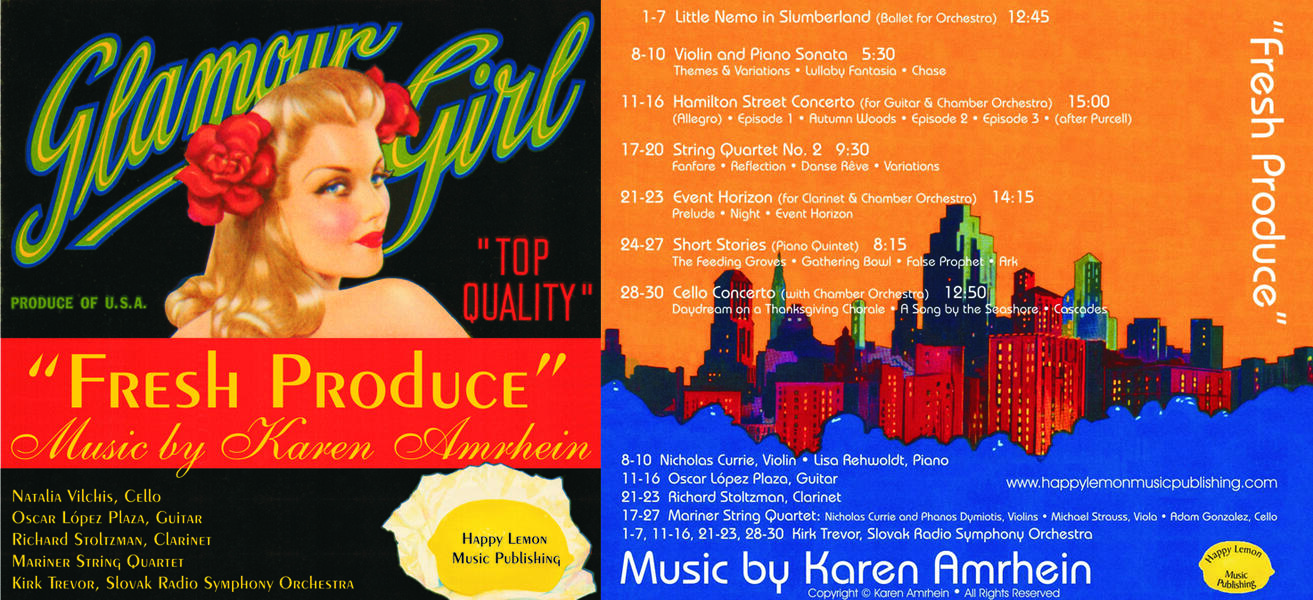 "Fresh Produce" CD Cover
"Fresh Produce" CD Cover"Fresh Produce" contains seven of my musical works. This generous release includes almost eighty-minutes of delightful music.
Available for PurchaseMusic scores and recordings by Karen Amrhein, including "Fresh Produce", are available for purchase from the Happy Lemon Music Publishing website:
http://www.happylemonmusicpublishing.com/ OR http://karenamrhein.com/
-
Little Nemo in Slumberland (Tone Poem)
"Little Nemo in Slumberland" was initially composed for Harlan Parker and the Peabody Wind Ensemble, and later arranged and expanded for orchestra. My symphonic poem is based on the groundbreaking comic strip by Winsor McCay created just ten years after the invention of the American comic strip. "Little Nemo" ran from 1904-1915 and depicts the nightly adventures of a little boy whose dreams take him to Slumberland. Each adventure comes to an abrupt end when Nemo invariably falls out of bed.
My symphonic poem is prefaced with an optional Fanfare for trumpet quartet, followed by the ballet proper: introductions to the principal characters (King Morpheus, Little Nemo, Flip, The Princess, and Doctor Pill) and an Adventure. After Nemo falls out of his bed with a crash, the ballet concludes with a gentle chiming of the clock, followed by an optional Farewell for trumpet quartet.Available for PurchaseMusic scores and recordings by Karen Amrhein, including "Fresh Produce", are available for purchase from the Happy Lemon Music Publishing website:
http://www.happylemonmusicpublishing.com/ OR http://karenamrhein.com/
-
Violin & Piano Sonata 1 Themes & Variations
"Themes and Variations" consists of six variations on a solo violin theme and the subsequent themes that arise from the primary. The music is performed by Nicholas Currie and Lisa Rehwoldt.
Available for PurchaseMusic scores and recordings by Karen Amrhein, including "Fresh Produce", are available for purchase from the Happy Lemon Music Publishing website:
http://www.happylemonmusicpublishing.com/ OR http://karenamrhein.com/
-
"Hamilton Street Concerto" 1 Allegro comodo
"Hamilton Street Concerto" is a concerto sandwich of orchestral bread and solo filing: three orchestral movements — I. (Allegro comodo), III. Autumn Woods, and VI. (after Purcell) — are separated by two solo episodes and an episode for flute and guitar called "Two, for Moonlight". The final movement "(after Purcell)" has its starting point, structurally speaking, in the last movement of Purcell’s "Sonata for Trumpet and Strings".
I’d have been unable to write this work without the help of my friend Oscar Lopez Plaza. I’m grateful that I had the opportunity to work with such a fine musician, during both the writing and recording processes. Oscar performs on the guitar, accompanied by the Slovak Radio Symphony Orchestra.Available for PurchaseMusic scores and recordings by Karen Amrhein, including "Fresh Produce", are available for purchase from the Happy Lemon Music Publishing website:
http://www.happylemonmusicpublishing.com/ OR http://karenamrhein.com/
-
String Quartet 2 ~ 3 Danse Rêve
Written for my friend Nicholas Currie and the Mariner String Quartet, my second quartet opens with a brief Fanfare, begun initially as a work for brass and revised and expanded for this string quartet. Two introspective movements follow, the second a dream dance that I liked so much I also used it in my "Variants" for flute & guitar and strings. "Variations" reworks material from the preceding movements before concluding with a return to the Fanfare.
Available for PurchaseMusic scores and recordings by Karen Amrhein, including "Fresh Produce", are available for purchase from the Happy Lemon Music Publishing website:
http://www.happylemonmusicpublishing.com/ OR http://karenamrhein.com/
-
"Event Horizon" 3 Event Horizon
I wrote "Event Horizon" after reading William J. Kaufmann’s "Black Holes and Warped Spacetime". The title of my piece is taken from the term that astronomers use to describe the perimeter of a black hole. In theory, all matter and energy that crosses this threshold cannot escape the unimaginably immense gravitational pull of the hole. The event horizon is, quite literally, the point of no return.
Available for PurchaseMusic scores and recordings by Karen Amrhein, including "Fresh Produce", are available for purchase from the Happy Lemon Music Publishing website:
http://www.happylemonmusicpublishing.com/ OR http://karenamrhein.com/
-
"Short Stories" 1 The Feeding Groves
The four brief pieces for piano and string quartet that comprise my "Short Stories" are inspired-by and evocative-of four short stories I wrote: "The Feeding Groves", "Gathering Bowl", "False Prophet", and Ark. This is the first of the four.
Available for PurchaseMusic scores and recordings by Karen Amrhein, including "Fresh Produce", are available for purchase from the Happy Lemon Music Publishing website:
http://www.happylemonmusicpublishing.com/ OR http://karenamrhein.com/
-
Cello Concerto 1 Daydream on a Thanksgiving Chorale
My three-movement Cello Concerto is an arrangement and expansion of my Euphonium Concerto. The "Daydream" first movement is a fantasia on a hymn-like tune that concludes with the violas initiating the first "variation" — a brief canon in 5/8 time climaxing with the soloist's entrance. The canonic music is reworked and reprised. next comes a more pensive "variation", then brisk and sunny "strolling music". The canon returns (in variation) and the music grows animated through to the finish. The daydream vanishes.
Peabody alumna Natalia Vilchis is the soloist, accompanied by the Bohuslav Martinu Philhamonic.
Available for PurchaseMusic scores and recordings by Karen Amrhein, including "Fresh Produce", are available for purchase from the Happy Lemon Music Publishing website:
http://www.happylemonmusicpublishing.com/ OR http://karenamrhein.com/
-
Event Horizon ~ YouTube Video
I wrote "Event Horizon" after reading William J. Kaufmann’s "Black Holes and Warped Spacetime". The title of my piece is taken from the term that astronomers use to describe the perimeter of a black hole.
This video includes a full performance of the three movement work, along with a page-by-page display of the full score. The music is performance by clarinetist Richard Stoltzman, accompanied by Kirk Trevor and Slovak Radio Symphony Orchestra.
Available for PurchaseMusic scores and recordings by Karen Amrhein are available for purchase from the Happy Lemon Music Publishing website:
http://www.happylemonmusicpublishing.com/ OR http://karenamrhein.com/
-
Little Nemo in Slumberland (Tone Poem) ~ Ballet Performance Video
My symphonic poem is based on the groundbreaking comic strip by Winsor McCay created just ten years after the invention of the American comic strip. "Little Nemo" ran from 1904-1915 and depicts the nightly adventures of a little boy whose dreams take him to Slumberland. Each adventure comes to an abrupt end when Nemo invariably falls out of bed.
The Harford Ballet company danced my "Little Nemo in Slumberland", and this video includes a full performance with the dance company, along with a page-by-page display of the full score. The music is performance by Kirk Trevor and Slovak Radio Symphony Orchestra.
Available for PurchaseMusic scores and recordings by Karen Amrhein are available for purchase from the Happy Lemon Music Publishing website:
http://www.happylemonmusicpublishing.com/ OR http://karenamrhein.com/
Short Stories ~ CD Album of Music by Karen Amrhein
Each movement of each of the works on "Short Stories" is an (admittedly abstract) short story of emotion. In some cases ("An Avandalian Suite", for example) the music is inspired from actual short stories. However you choose to describe it, whatever title you use, I hope that you enjoy "Short Stories", a generous release of almost eighty-minutes of original music for orchestra, for chamber ensemble, and for choir.
As with all my CDs, I acted as producer, recording engineer (for the chamber music), artistic designer (for the CD booklet, tray card, and disc), music contractor, and of course composer. I also performed the music editing on "An Avandalian Suite" and the chamber music pieces.
-
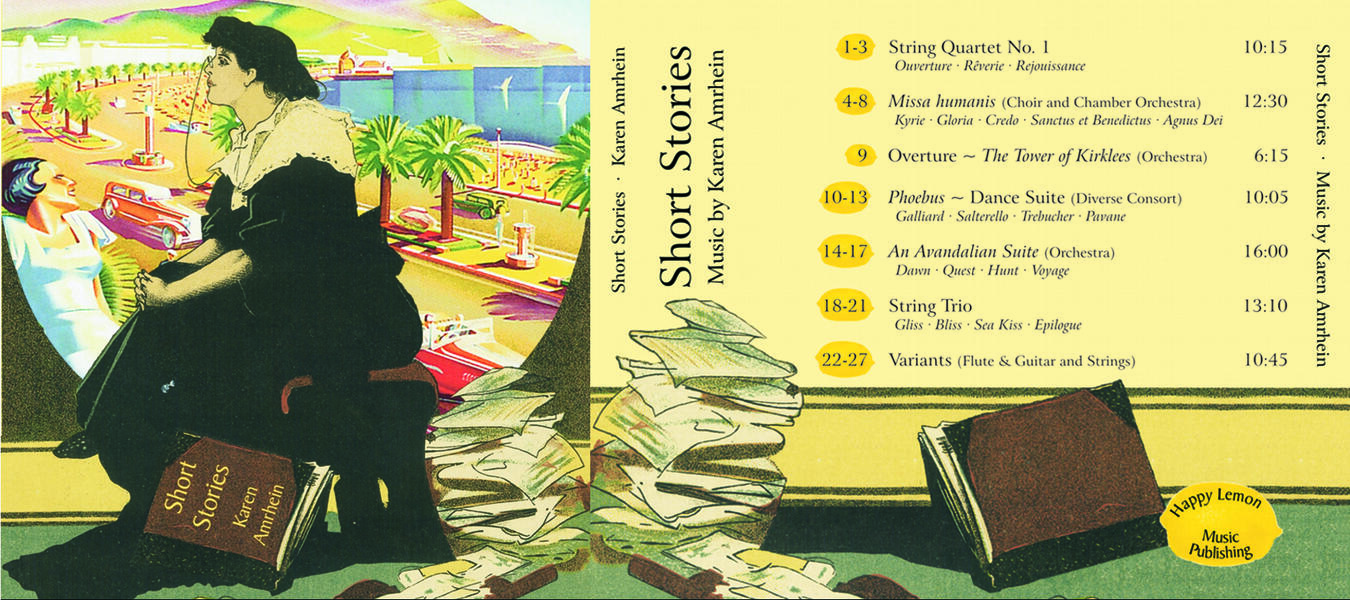 Short Stories CD Cover
Short Stories CD CoverEach movement of each of the works on "Short Stories" is an (admittedly abstract) short story of emotion. In some cases ("An Avandalian Suite", for example) the music is inspired from actual short stories. However you choose to describe it, whatever title you use, I hope that you enjoy "Short Stories", a generous release of almost eighty-minutes of original music for orchestra, for chamber ensemble, and for choir.
Available for PurchaseMusic scores and recordings by Karen Amrhein, including "Short Stories", are available for purchase from the Happy Lemon Music Publishing website:
http://www.happylemonmusicpublishing.com/ OR http://karenamrhein.com/
-
String Quartet 1 ~ Ouverture
The Ouverture is a theme (really a motive) and variations, but also an exercise in rapidly shifting dynamics and textures. The motive (an arpeggio of a m3, M2, M3, and m3) appears first in variation in the opening bars, and then is subsequently reworked until the Ouverture climaxes at a coda that fuses a two-voice fugue with elements from the introduction.
Available for PurchaseMusic scores and recordings by Karen Amrhein, including "Short Stories", are available for purchase from the Happy Lemon Music Publishing website:
http://www.happylemonmusicpublishing.com/ OR http://karenamrhein.com/
-
Missa humanis 5 Agnus Dei
I had the impertinence to write my little mass after hearing a performance of Beethoven's "Missa solemnis", a work that, I regret to say, moved me in just one way, to compose a mass of my own: brief, rhythmic, and punchy — a humane mass. I eschewed the repetition inherent in most masses, liberally cut
from the Credo text, and turned to Bach for inspiration and instruction in part writing.Available for PurchaseMusic scores and recordings by Karen Amrhein, including "Missa humanis", are available for purchase from the Happy Lemon Music Publishing website:
http://www.happylemonmusicpublishing.com/ OR http://karenamrhein.com/
-
Overture ~ The Tower of Kirklees
This serves as a tone-portrait introduction to my novel of the same name.
Available for PurchaseMusic scores and recordings by Karen Amrhein are available for purchase from the Happy Lemon Music Publishing website:
http://www.happylemonmusicpublishing.com/ OR http://karenamrhein.com/
-
"Phoebus" ~ Dance Suite for Diverse Consort
Here are pseudo-Renaissance dances written as incidental music for my novel "The Eye of Phoebus". The diverse consort is flute, recorder, clarinet, percussion (claves, cymbal, small drum, tambourine, triangle, woodblock), and piano — performed by me! The galliard, salterello, and pavane are standard Renaissance dance forms (if altered somewhat here). The trebucher is my own form.
The video offers a complete recording, played as the full score is displayed.
Available for PurchaseMusic scores and recordings by Karen Amrhein are available for purchase from the Happy Lemon Music Publishing website:
http://www.happylemonmusicpublishing.com/ OR http://karenamrhein.com/
-
An Avandalian Suite 1 Dawn
"An Avandalian Suite" consists of four symphonic poems inspired-by and "reciting" four tales from J.R.R. Tolkien's The Silmarillion. I didn't want the trouble or expense of purchasing continual copyright permission for the names of the movements (and suite), so I gave them names of my own.
Available for PurchaseMusic scores and recordings by Karen Amrhein are available for purchase from the Happy Lemon Music Publishing website:
http://www.happylemonmusicpublishing.com/ OR http://karenamrhein.com/
-
String Trio ~ YouTube Video
Written in memory of Phanos Dymiotis, a violinist and composer who was a member of the Mariner String Quartet, my string trio is perhaps my most sober work.
The video includes the full recording of all four movements, heard while the score is displayed, page by page.
Available for PurchaseMusic scores and recordings by Karen Amrhein are available for purchase from the Happy Lemon Music Publishing website:
http://www.happylemonmusicpublishing.com/ OR http://karenamrhein.com/
-
Variants ~ for Flute & Guitar and Strings ~ Video
The six Variants are intended to link almost seamlessly, though there is a short pause before and after Variant 4 — a variation itself of the Danse Rève from my String Quartet No. 2. Each variant is a theme and variations unto itself, however material from one variant may be developed further in another. Variant 5 is a fugue in Dorian mode with a passacaglia inside. The final variant is a joyous romp.
This YouTube video features a performance by flutist Kimberly Zaleski, guitarist Mark Edwards, and the strings of the Bohuslav Martinu Philharmonic, while each page of the full score is displayed in co-ordination with the music.
Available for PurchaseMusic scores and recordings by Karen Amrhein are available for purchase from the Happy Lemon Music Publishing website:
http://www.happylemonmusicpublishing.com/ OR http://karenamrhein.com/
YouTube Music Score Videos by Karen Amrhein
I've made dozens of videos for YouTube that include full recordings of my chamber, orchestral, and vocal music. Each video includes the music score, with each page of the score changing along with the music. Often, classic artworks are also featured alongside the music score. I invite you to visit my YouTube channel: @HappyLemonMusic
-
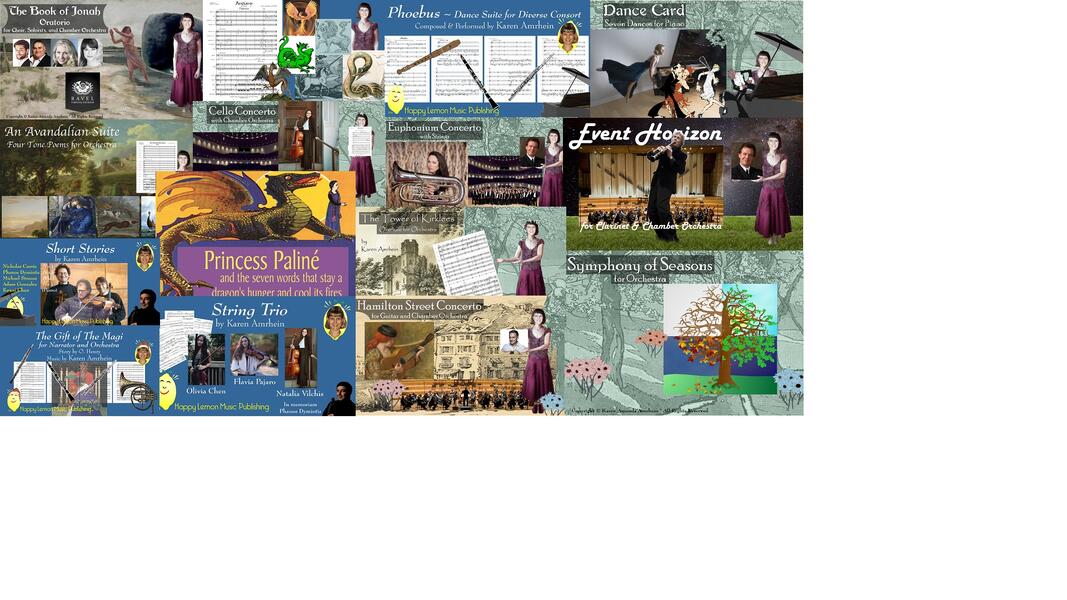 YouTube Music Score Videos by Karen Amrhein
YouTube Music Score Videos by Karen AmrheinI've made dozens of videos for YouTube that include full recordings of my chamber, orchestral, and vocal music. Each video includes the music score, with each page of the score changing along with the music. Often, classic artworks are also featured alongside the music score. I invite you to visit my YouTube channel: @HappyLemonMusic
The link to the channel is: https://www.youtube.com/@HappyLemonMusic/videos
-
@HappyLemonMusic YouTube Channel
At the YouTube channel @HappyLemonMusic you'll find dozens of videos I created, featuring full recordings of my chamber, orchestral, and vocal music. Each video includes the music score, with each page of the score changing along with the music. Often, classic artworks also appear alongside the music score.
The link to the channel is: https://www.youtube.com/@HappyLemonMusic/videos
The YouTube link I provided for this media sample is for my piano suite "Dance Card". (The "Add Remote Video" function of the Baker Artist website would not permit me to use the more general: https://www.youtube.com/@HappyLemonMusic/videos .)
Little Nemo in Slumberland ~ Ballet
Some years ago I composed what I then considered a full ballet, "Little Nemo in Slumberland". That piece is ten-minutes in length (plus two one-minute trumpet fanfares that bookend it), and I worked with The Harford Ballet Company to stage it. It was performed, along with their main attraction, a "Wizard of Oz" ballet.
"Little Nemo in Slumberland" was initially composed for Harlan Parker and the Peabody Wind Ensemble, and later arranged and expanded for orchestra. It is based-upon and inspired-by the groundbreaking comic strip by Winsor McCay created just ten years after the invention of the American comic strip. "Little Nemo" ran from 1904-1915 and depicts the nightly adventures of a little boy whose dreams take him to Slumberland. Each adventure comes to an abrupt end when Nemo invariably falls out of bed.
In 2024 I realized that the ten-minute work was best understood as a symphonic poem, and I desired to write additional music and scenario to create a full 45-minute (or so) ballet.
Now, in 2025, I've completed the music and scenario for the first tableau (around fifteen minutes in length), which depicts the lonely Princess entreating her father, King Morpheus, to bring Little Nemo to Slumberland. As in the comic strip, the imp Flip tries to interfere, necessitating the ministrations of Doctor Pill to keep Little Nemo from awakening. Doctor Pill succeeds (if temporarily), and Nemo and The Princess dance together.
I envision further tableaux in which Nemo and The Princess have adventures together, culminating in Nemo's final adventure in Slumberland which ends as Flip succeeds in his mischief and Nemo falls out of his bed with a crash. Slumberland vanishes as he awakes, and the ballet concludes with a gentle chiming of the clock, followed by the Farewell for trumpet quartet.
I invite you to sample the several musical excerpts from the first tableau.
-
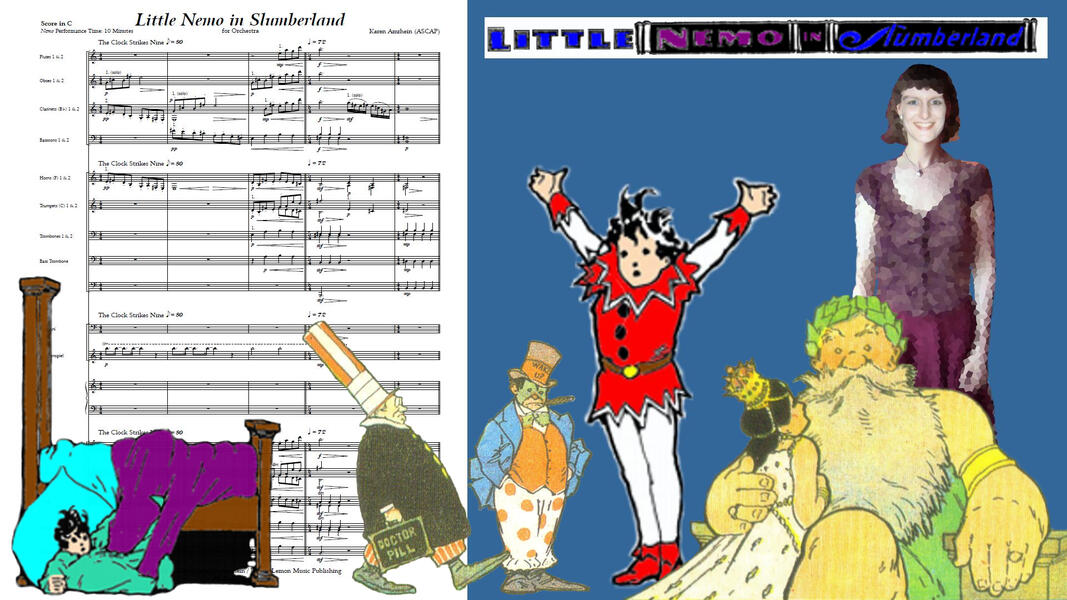 Little Nemo in Slumberland ~ Ballet Project
Little Nemo in Slumberland ~ Ballet ProjectHere are several characters (drawn by cartoonist Winsor McCay), alongside me (the composer) and a page from the ballet score.
-
Little Nemo ~ Ballet ~ King Morpheus Theme
This is the theme for King Morpheus, ruler of Slumberland.
-
Little Nemo ~ Ballet ~ The Princess Dances for Her Father
This is an excerpt from the music that depicts The Princess entreating her father, King Morpheus, to bring Little Nemo to Slumberland.
-
Little Nemo ~ Ballet ~ Little Nemo Theme
This is an excerpt from Little Nemo's theme.
-
Little Nemo ~ Ballet ~ The Princess Theme
This is the conclusion of Tableau 1: The Princess dancing with Little Nemo.
The Book of Jonah ~ Oratorio by Karen Amrhein
I researched and prepared for a full year (learning a lot about sea shanties, among other things), and then spent two years composing the oratorio, "The Book of Jonah", which is far and away my largest (at 48 minutes) and most significant composition to date. To the best of my knowledge, it is the only musical setting of the complete book of Jonah from the Bible, apart from Hungarian composer Emil Petrovics’ 1966 oratorio. My oratorio (for two tenor soloists – representing the narrator and the prophet Jonah – choir, and chamber orchestra) employs the complete text of the four-chapter story, with six psalms for choir interposed as commentary on the narrative.
The book of Jonah tells of a man who is called on by God to issue a warning to the enemies of Jonah’s people, flees from God to avoid the task, finds that flight from God is impossible, and reluctantly gives the message to his enemies who, to his irritation, repent and are spared.
I am strongly drawn to this story because of the very recognizable and universal characteristics of Jonah (anger, fear, foolishness, arrogance, lack of compassion, but also courage and faith), and the humor and humanity of the story. Jonah is one of those rare Biblical characters I can relate to, and his story has wit, drama, philosophy, action, and deep emotion.
In order to record my oratorio affordably, I employed a small group of singers (two sopranos / altos, two tenors, and one bass), and a virtual chamber orchestra performed by Ravel Virtual Studios. In September 2024 and February 2025 the Bratislava Symphony Orchestra recorded some of the strings music for the oratorio, which I integrated into the vocal and other instrumental recordings.
This project is extremely important to me. As mentioned above, “The Book of Jonah” oratorio is my largest and most significant composition. The music is the best I’ve been blessed to have written, and the oratorio can stand without shame in the canon of great choral works.
My oratorio is full of melodies and musical contrasts, and even the recitative is tuneful and memorable. In addition to the story itself, "The Book of Jonah" includes six psalm settings, which serve to offer emotional commentary on the action. The music reinforces and amplifies a story that is much more than a fable about a prophet being swallowed by a great fish. It is a story of a man who has a remarkably personal and honest relationship with God, with whom he disputes and complains, praises and obeys, and upon whose mercy he depends, but still resents when that mercy is extended to others.
-
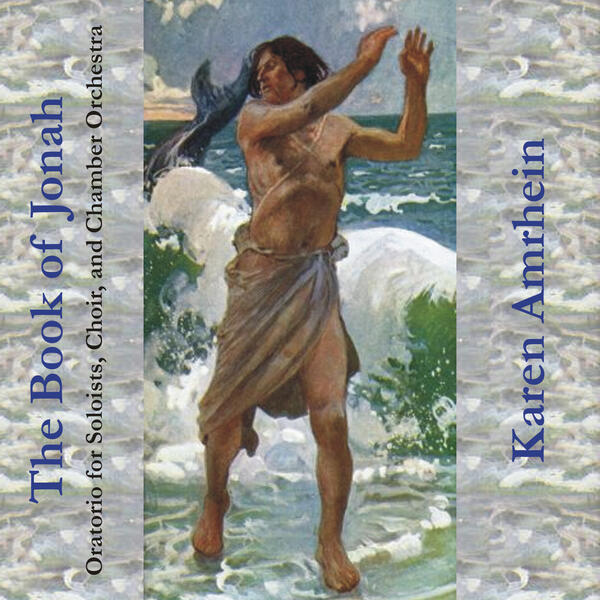 The Book of Jonah ~ Album Cover
The Book of Jonah ~ Album CoverThis is the cover for the CD of "The Book of Jonah" Oratorio.
Available for PurchaseMusic scores and recordings by Karen Amrhein, including "The Book of Jonah", are available for purchase from the Happy Lemon Music Publishing website:
http://www.happylemonmusicpublishing.com/ OR http://karenamrhein.com/
-
The Book of Jonah ~ Oratorio ~ Music Video
This is my YouTube video of the complete oratorio, with classic paintings of Jonah and Nineveh, alongside the full score, page by page.
-
The Book of Jonah ~ Prelude
Here is the three-minute Prelude (or overture) to "The Book of Jonah" oratorio. The music captures the drive and excitement of "The Mariners Were Afraid" section of the work.
Available for PurchaseMusic scores and recordings by Karen Amrhein, including "The Book of Jonah", are available for purchase from the Happy Lemon Music Publishing website:
http://www.happylemonmusicpublishing.com/ OR http://karenamrhein.com/
-
The Book of Jonah ~ The Mariners Were Afraid
In this section of the oratorio, the mariners aboard Jonah's ship are terrified because the fierce tempest threatens to send them all to the bottom of the sea. The ask Jonah about himself, and he confesses that the storm has come from God because Jonah has disobeyed God. The mariners reluctantly cast Jonah overboard -- as he requests -- and the storm is stilled.
Available for PurchaseMusic scores and recordings by Karen Amrhein, including "The Book of Jonah", are available for purchase from the Happy Lemon Music Publishing website:
http://www.happylemonmusicpublishing.com/ OR http://karenamrhein.com/
-
The Book of Jonah ~ Chorus 4 ~ Psalm 29
This is the chorus of thanksgiving that the mariners offer to God after their deliverance from the tempest.
Available for PurchaseMusic scores and recordings by Karen Amrhein, including "The Book of Jonah", are available for purchase from the Happy Lemon Music Publishing website:
http://www.happylemonmusicpublishing.com/ OR http://karenamrhein.com/
-
Jonah 3 Passacaglia.mp3
This passacaglia (a series of variations upon a ground bass) serves as the "overture" to the third chapter of the story.
Available for PurchaseMusic scores and recordings by Karen Amrhein, including "The Book of Jonah", are available for purchase from the Happy Lemon Music Publishing website:
http://www.happylemonmusicpublishing.com/ OR http://karenamrhein.com/
-
The Book of Jonah ~ I Knew You
This is the beginning of the fourth and final chapter of the story. Here Jonah pouts because God has relented and forborne to punish Nineveh. Jonah complains to God, who responds tenderly by asking Jonah, in essence, have you any right to complain? Should I not be merciful?
Available for PurchaseMusic scores and recordings by Karen Amrhein, including "The Book of Jonah", are available for purchase from the Happy Lemon Music Publishing website:
http://www.happylemonmusicpublishing.com/ OR http://karenamrhein.com/
-
The Book of Jonah ~ Chorus 6 ~ Psalm 139
To cap-off the oratorio, I chose to re-set Psalm 139, and conclude with the great truth, expressed throughout the story in various ways: Where can I go from your presence, O God? The oratorio ends with a final plea to God: Hold me.
Available for PurchaseMusic scores and recordings by Karen Amrhein, including "The Book of Jonah", are available for purchase from the Happy Lemon Music Publishing website:
http://www.happylemonmusicpublishing.com/ OR http://karenamrhein.com/









